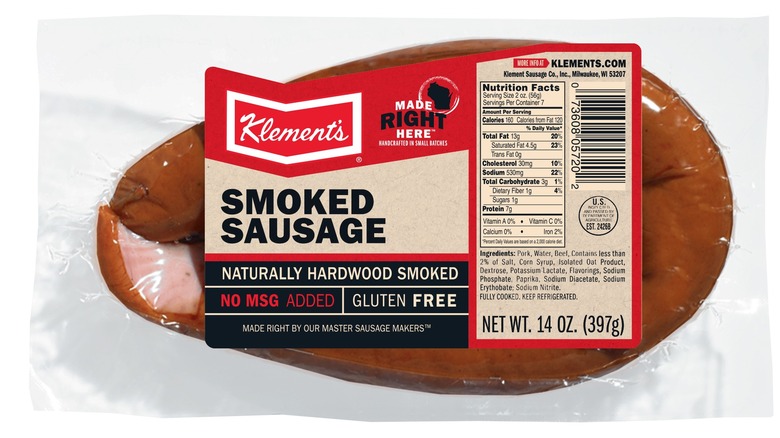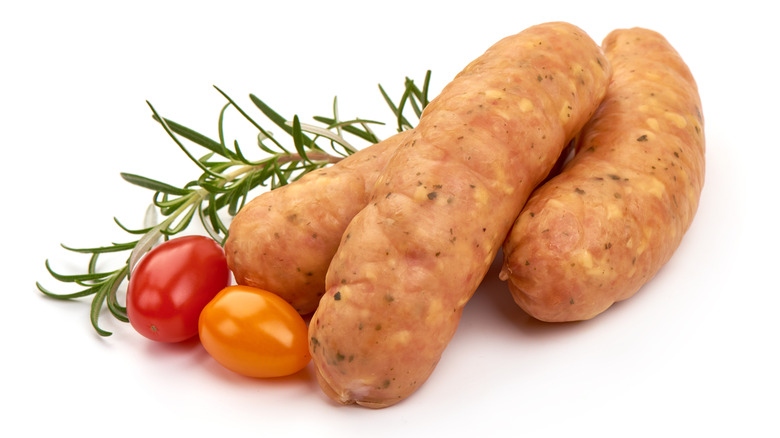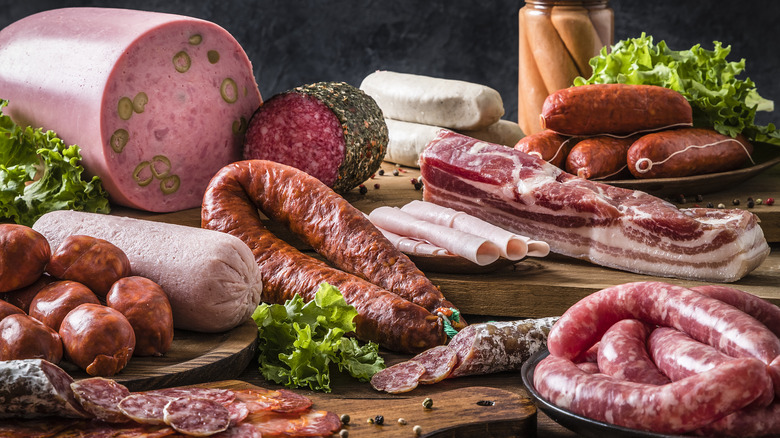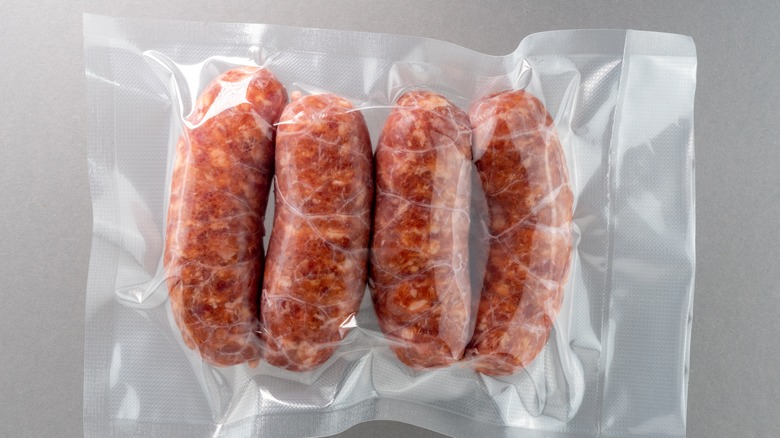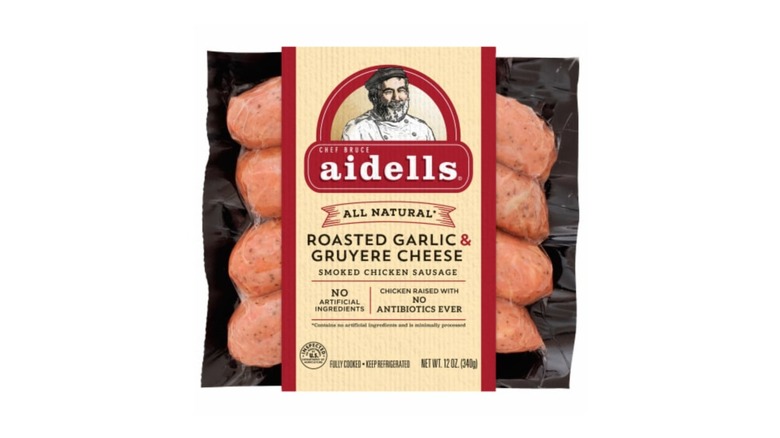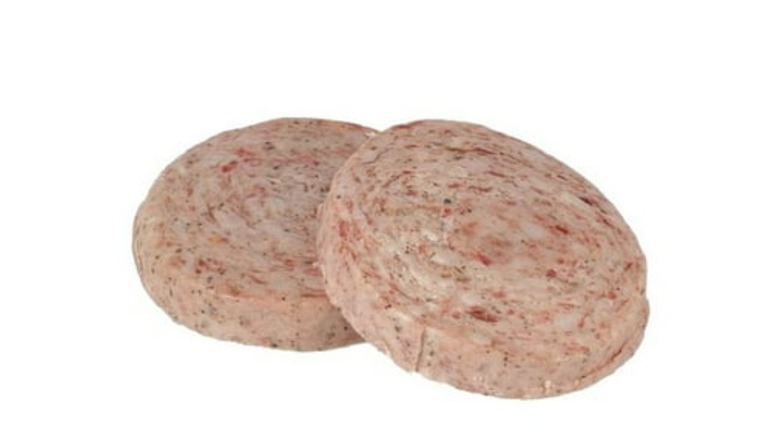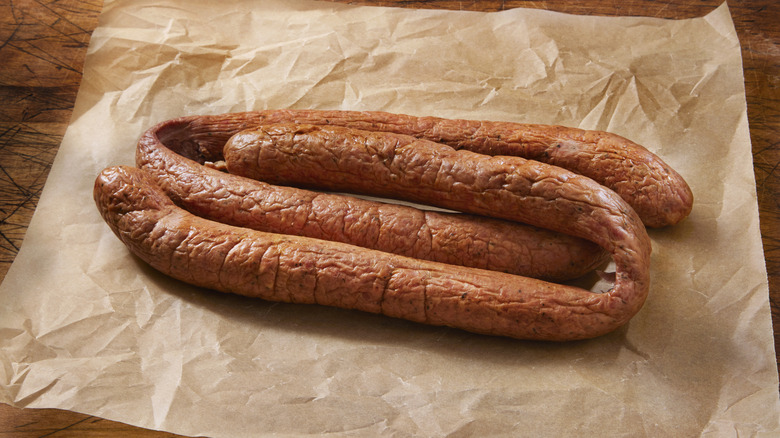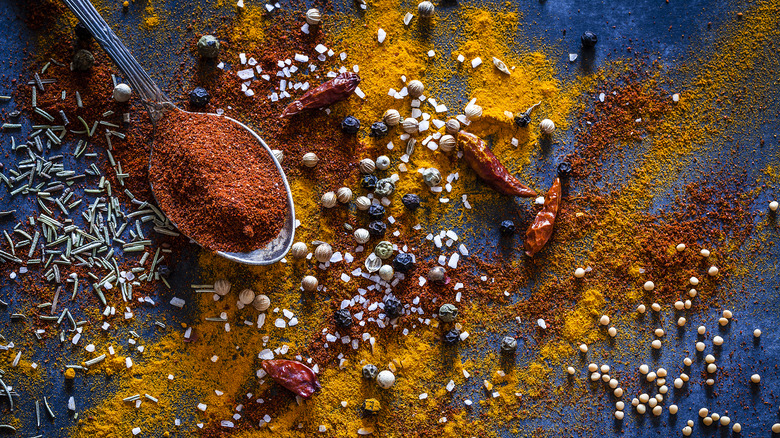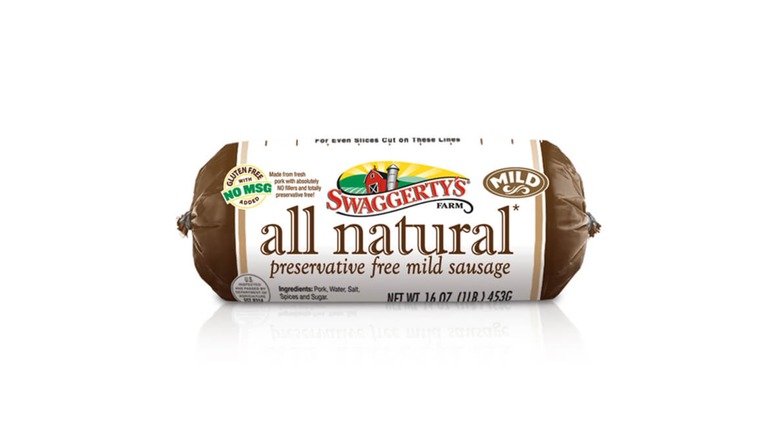Mistakes Everyone Makes When Buying Sausage
All sausages may seem the same when you're staring at the deli case, but is that really true? Perusing all of those packages of sausage in your local supermarket can prove to be a seriously salivating experience, to be sure. Still, a recent examination of some key brand labels has gotten us thinking that we might be doing things backward, at least when it comes to selecting the right kind of sausage to get our savory fix.
Now, we know you aren't likely to put down your favorite sausage brand simply because of what you read here, and honestly, you don't have to. But there is power in staying informed about the types of sausages you choose. From ways to decipher good sausages from bad, to methods you can learn for using them in new ways at home, we're here to disclose the information you need to turn yourself into a true sausage-buying pro.
Join us as we slice into the savory details of 11 of the most common mistakes people make when buying sausage and how you can avoid them in order to achieve sausage glory.
1. Thinking all sausage is composed of one type of meat
While many consumers often assume that sausages contain just one kind of meat (usually pork or beef), the reality is that many sausage brands out there contain more than one type of protein. These mixtures are often mechanically processed and can contain all sorts of interesting additions, many of which may move you to think twice when it comes to consuming these parts on their own.
Head meat, organs, and blood are only just a few examples of what you might find in certain sausages. These additions are often referred to as "mechanically deboned meat" fillers or "extenders" and can be scraps that are often used rather than simply being thrown away.
What is the purpose of these add-ins? They can be used to enhance the overall look of your sausage while also improving its shelf life. These fillers can help achieve plump, juicy, and overall attractive sausages and can save the manufacturer money, also while causing you to believe you're getting big, meaty portions of pork or beef. Instead, you'll receive a hodge-podge of mechanically separated turkey, pork, chicken, or a variety of other meats, and you won't necessarily have a good idea as to what parts of which animals were used. Brands like Bar-S, Hillshire, and Eckrich are some of the more common sausage brands to use this type of mix, though they are hardly alone.
2. Thinking local brands are always better
If you've ever seen food branded as "local," you may be inclined to believe that it's somehow better for you. Indeed, there are often quite a few advantages when it comes to buying locally sourced meats and produce, like lowered costs and increased environmental sustainability. However, buying local doesn't always mean you get a higher-quality or more nutritious product. What's more important there is considering the type of meat used and whether or not the company employs additives, fillers, extenders, and other products in its sausage manufacturing.
Take Klement's sausages, for example. This popular pork pick is sourced from Wisconsin, a state that's well-known for impeccable cheese and sausage. While the average local Badger-lovin' patron may assume these sausages are better, the truth is that they contain many of the same ingredients as other brands. Will they contain filler? Maybe, depending on how you want to define it — the brand's 14-ounce smoked sausage does contain water and isolated oat product. Additives? Yeah, sodium nitrate is on the list, too.
This is why it is important to compare the ingredients of your local sausage to one made by a brand-name manufacturer, especially if the price of the local one is higher. Sure, it's great to support local butchers and small businesses, but for the best sausage, check that higher quality is actually what you'll get.
3. Assuming natural or uncured varieties are healthier
Is eating uncured sausage better for your health? Maybe ... or maybe not. As shocking as it may seem, eating uncured or all-natural sausages may not always prove to be better for you, especially when it comes to nitrate consumption, as Consumer Reports found when it conducted original testing on multiple bacon brands. Sure, bacon and sausage aren't exactly the same, but the lessons learned there can hold true when you're shopping for sausage, too.
The misunderstanding regarding the difference between cured meat and uncured meat is that these uncured varieties are usually still technically cured, just with something different like celery powder or celery extract, which are known for high levels of nitrates. Because of this, experts aren't sure that these uncured meats are better for you, as you are still consuming nitrates, even if it's from a natural source.
Until researchers discover otherwise, it may be best to simply lay off any sort of cured or processed meat if nitrates bother you. Oh, and don't forget, these natural sausages often come with a high levels of sodium, fat, and calories, just as any other sort.
4. Assuming all types of sausages are made the same way
Many sausages out there get a bad rap, but it's important to note that not all sausage types are the same. Of course, you know there are differences between brands, but there are also differences between certain sausage types and the ingredients used to make them. For example, you'll seldom find as many additives in plain raw sausage as you would in smoked sausage. This no doubt has a lot to do with the differences in the respective shelf lives of the products — raw sausage will expire much faster than a cured and preserved one. Conversely, bratwursts may contain a variety of ingredients that your morning sausage links may or may not also contain. Ultimately, not all sausages should be viewed as the same — because they simply aren't.
So, what does this all mean? If you're one who worries about preservatives and other additives, you may wish to select raw sausages rather than preserved or precooked varieties. Though they aren't always additive-free, there are some raw sausages that contain minimal ingredients and sometimes are even made without the use of monosodium glutamate (MSG), a food additive with a somewhat checkered reputation. Ultimately, the best move is to read up about different types of sausage and keep an eye on the label when you're browsing the grocery store.
5. Always opting for the cheapest brand
Are you low on cash? It may be tempting to select the cheapest cuts of meat to feed yourself and your family, but not so fast. While we would never judge anyone who wants to save a few bucks, we do want you to be aware that cheaper brands are often cheap for a reason. Yes, that includes sausages, too.
Cheap sausage brands often use techniques to make their sausages more affordable, but not necessarily tastier, more filling, or more nutritious. Manufacturers will often pump their sausages full of meat fillers and extenders full of a variety of animal parts that you may not consume otherwise. But that isn't all. Cheaper sausage brands may also use non-meat fillers in the form of oats, flour, and other grains, which help to give the sausages the appearance of plumpness when, in reality, they're actually loaded with non-meat filler.
Another way manufacturers deceive the eye is to inject sausages with water. While this isn't necessarily something that would harm your health, the water often evaporates once your sausage hits heat. You're then possibly left with a shriveled-up shadow of what you started with. Though the cheapest options may be what sounds best for your wallet, bear in mind you aren't just consuming meat, but a bevy of other components that are all part of what makes the sausage cheap by the time it hits grocery stores.
6. Thinking more expensive means better
Just as it may be tempting to purchase cheaper options when your budget is tight, it can also be tempting to shell out for expensive brands with fancier packaging over cheaper ones. While it is true that expensive sausages sometimes have advantages over the more inexpensive ones, you'll need to maintain a discerning eye to know for sure. For example, brands like Kiolbassa found at Sam's Club may seem to be of higher quality than your typical Hillshire Farm sausage based on the packaging alone. In reality, the ingredients are quite similar. We do at least commend the Kiolbassa brand for not using fillers and MSG, but the product still contains a couple of additives and nitrates meant to preserve the meat.
To be clear, we aren't saying that there's anything inherently wrong with either cheap or expensive brands, but it helps to know what you're buying in order to determine whether or not the upcharge is actually worth it to you. So, take the time to check labels and consider if you want to be leery of ingredients that are difficult to pronounce, especially if there are many of them listed on the packaging.
7. Forgetting about chicken and turkey sausage options
It can be easy to get into a sausage rut. But if that happens to you, never fear, for there are many other sausage options on the market these days that getting acquainted with other varieties will be worth it. Chicken and turkey sausages sometimes provide lower-fat options, which can make them ideal for people with certain dietary restrictions. These varieties may also contain fewer additives, although this won't always be the case, so read your labels. If nothing else, turkey and chicken sausages can provide a unique twist on traditional sausage flavor. Who knows — you may find that your tastebuds quite enjoy the difference.
So, what brands are out there? Aidells offers up chicken sausages infused with interesting flavors and which are often processed with very minimal ingredients. Simple Truth, a Kroger house brand, features chicken and turkey sausage varieties, both of which contain relatively minimal ingredients, especially when compared to other, more popular brands on the market.
Other brands like Butterball, Hillshire, Eckrich, and other common sausage labels also put out their own versions of turkey sausage, though they may come stuffed full of extra ingredients that you may or may not care about consuming.
8. Buying frozen sausage patties instead of fresh
Buying a bunch of pre-sliced, precooked frozen sausage patties is pretty nifty, isn't it? After all, we all know what it's like to be short on time in the morning, and having half the work done for us as far as breakfast and hungry families are concerned is pretty darn exciting. Even so, there are a few pitfalls to be aware of when you're out buying pre-sliced or premade sausages.
The first and most obvious reason you may wish to skip on pre-sliced and precooked sausages is that it'll cost you more in the long run. Take Kroger's pre-sliced Traditional Pork Sausage patties as an example. You'll get 12 ounces of sausage for around $3 at the time of publication. In this sausage, you'll also find quite a few additives, even though this is meant to be a take on the traditional raw breakfast sausage. The Kroger Mild Pork Sausage Roll, on the other hand, contains only five ingredients, none of which are additives, and only costs $2 at the time of publication.
Think this a coincidence? It hardly is. For another example, look at Jimmy Dean sausage varieties in your local store. You'll like find, as we did, that a box of precooked Jimmy Dean patties will cost more per ounce than a raw Jimmy Dean breakfast sausage roll. We think the best thing to do is to simply buy a roll of sausage, slice it up yourself, and freeze the patties.
9. Not staying well-versed in sausage varieties
If you really want to get into it, then the truth is that different sausages have different functions. When it's time to buy, knowing what you need for your kitchen it key. Discerning between sausages can be easy for those who cook often or have grown up eating different varieties of the stuff, but may not prove so for someone who isn't privy to the world of savory pork. By staying well-versed in the different types of sausages available, you'll have a better time selecting the type you need to help your at-home recipes stand out.
Andouille, for instance, is a type of sausage that works especially well in Cajun and Creole seasoned dishes. This sausage variety is heaped with yummy spices, most of which lean toward heat and unmistakable flavor. It's often smoked, too, which adds to its appeal and can add a wonderful flavor to meals like jambalaya, stew, and more. Meanwhile, summer sausage is a variety created in pre-refrigeration Europe, namely Germany. Its relatively soft texture proves to be excellent when it's paired with cheese and crackers. This makes it a wonderful addition for your guests to sample upon your next perfectly made charcuterie board.
Of course, that's just the tip of the sausage-berg. Other types of sausage include Italian sausages, kielbasa, brats, and many more. Do a little research on each one, and you'll know just which to pick to satisfy your next round of savory cravings.
10. Forgetting to spice up sausages yourself
Are your sausages coming across a bit drab? Even if not, sausages that have amazing flavor could perhaps still benefit from a little boost. After all, could a sausage ever actually have too much flavor? We think not. Because of this, it can help to have a few spices and liquids on hand to spruce up your meat before dishing it up.
One of our favorite tricks for adding more flavor to sausage includes adding crushed red pepper flakes, garlic, freshly cracked black pepper, Italian seasoning, or dried sage to uncased raw sausages. Adding these seasonings can give the sausage a flavor boost without needing to spend extra on sausages that already come flavored. Another trick? Try cooking your sausages in broth, wine, or beer. All of these liquids can infuse your meat with more flavor than boiling in water or searing will do alone.
One last way to infuse your sausages with flavor is a classic: cook them up with peppers and onions. We all know how flavorful peppers and onions can be, but when paired with the spicy taste of sausage, the taste is oftentimes simply unmatched.
11. Believing all sausage brands contain MSG or other additives
Though it may seem inescapable, the reality is that there are sausages out there that are free of MSG and other additives — you just have to know what to look for. Several major brands, including Jimmy Dean, now offer natural versions of sausages that contain few to no additives. Other brands offering natural sausage include Bob Evans, Johnsonville, and more. Fair warning, though — you may or may not see these in your local grocery store, as each of these natural sausage products are subject to availability. Still, paying close attention to the label will help you weed out the kinds of sausages that you may want to try over other ones. Phrases like "no MSG," all-natural," "preservative-free," or "no fillers" are good starting points when attempting to choose a higher-quality sausage. Of course, at the risk of sounding repetitive, you should always take a minute to look over the ingredients list to ensure that it meets your standard.
Also, don't forget to check out those turkey and chicken sausages we told you about earlier. Some may well contain fewer preservatives and other additives. They will also taste different from what you're used to if eating pork sausages has always been your thing. Still, it helps to look into these less frequently purchased lean meat sausages, especially if you have concerns about what kind of byproducts or other ingredients get mixed into your sausages.


